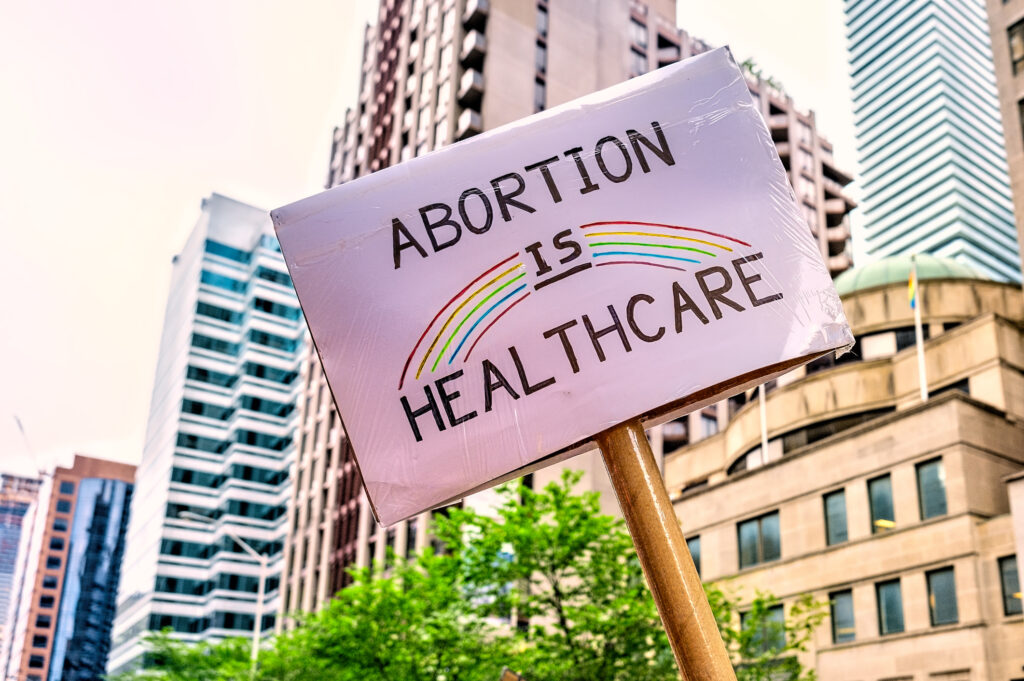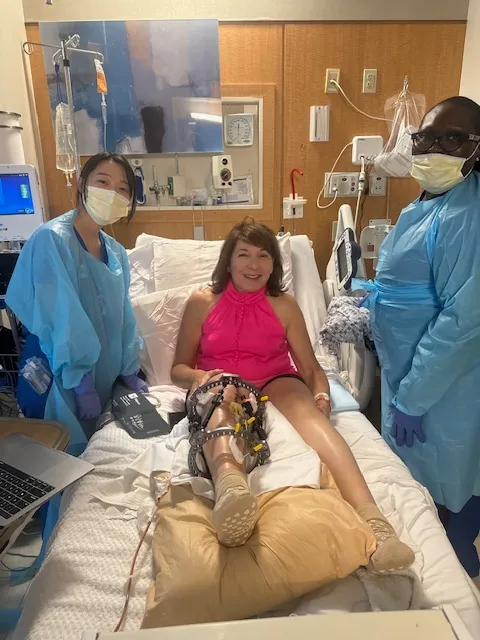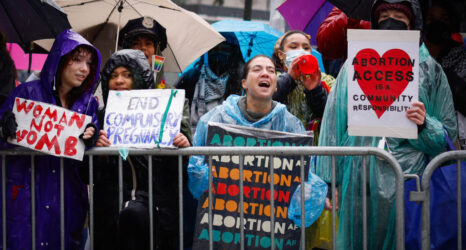Twenty-one American states have abortion bans. The women in these states do not have access to the same top medical care in their states as men do. Are we okay with that?

After accidentally publishing its decision a day early, a U.S. Supreme Court ruling has come down in a major abortion case: For now, the federal Emergency Medical Treatment and Labor Act (EMTALA) preempts Idaho’s near-total abortion ban. EMTALA requires Medicare-funded hospitals—which make up the large majority of hospitals—to provide emergency care, including abortion, to any person experiencing a medical emergency. However, providers can still face severe prosecution for failing to judge an emergency situation as such, which will no doubt deter them from providing abortions when they are needed, leaving women without the medical care they rightfully deserve.
This month, I had the privilege of experiencing the very best of American modern medicine. I had to have knee surgery to correct my knee which had lost cartilage on the right side, sliding the knee bones all the way over to the left side, making it painful to run and eventually even to walk.
Sorry if that is TMI for you all, but my point is that it was a necessary, major operation; yet, it’s something that is done thousands of times all across this country by highly trained surgeons and their teams. It was 21st-century medicine and its goal is to get me back to all the running, hiking and dancing I am desperate to do again.
Lots of you, no doubt, have had surgeries like this to repair wonky joints or even faltering organs, and you are now fit and living your best lives again today. We celebrate our American medical system as the best in the world—if only all of us could afford it—and clap our American selves on the backs for being the most technologically advanced country in the world, with the top universities, the brightest minds and the most entrepreneurial ingenuity.
So why would we voluntarily decide to deny the top-notch medical care that I just received this past week to women in 21 states with abortion bans in our country?

Justice Alito’s Dissent
In his dissent, Justice Samuel Alito, joined by Justices Neil Gorsuch and Clarence Thomas, claimed that EMTALA does not preempt Idaho’s law and that EMTALA “unambiguously demands that Medicare funded hospitals protect the health of both a pregnant woman and her ‘unborn child.’”
Alito also argued that EMTALA’s preemption conflicts with the Hyde Amendment, which bars the use of federal funds for abortions, stating that “congress could apparently pay doctors to perform not only emergency abortions but also third-trimester elective abortions or eugenic abortions.”
Jessica Valenti, author of Abortion Everyday, points out how Alito views EMTALA as requiring doctors to treat the lives of women and their “unborn child” equally in an emergency situation: “He claims that the law mandates that hospitals ‘protect’ fetuses ‘at every stage’ that a woman is being treated—even writing that a transfer to another hospital can only be done if a physician ‘certifies’ that the medical benefits outweigh increased risks to the fetus.”
Additionally, SCOTUS has refused to protect women in need of life-saving abortions in abortion-ban states other than Idaho, leaving women across the country at risk for being denied emergency care.
Twenty-one American states now have laws that ban abortion from conception or at various stages up to 12 weeks, including Tennessee, Georgia, Alabama, North Dakota and South Dakota. Utah allows abortions up to 18 weeks. About 25 million women of reproductive age live in these states.
They now do not have the right to the same top medical care in their states as men do. Are we all okay with that?
The Importance of Emergency Medical Care
When I went to see my surgeon for a follow-up appointment, he immediately saw on an X-ray that something had gone seriously awry with the healing process. He feared an infection had possibly set in, and he took instant action: “You aren’t going home, I’m checking you right into the hospital and we’re operating tomorrow morning.”
Off I was whooshed for all the pre-surgery tests and boom, the next morning, I was on the operating table for my bones to be readjusted, tests for infection sent off and a new device implanted to hold everything in place. Then it was days of scrupulous testing and antibiotics.
Here’s the thing that every American, no matter what their gender needs to let sink in: If I was pregnant and had just run into a serious complication threatening that pregnancy or I was miscarrying and I lived in one of those 21 American states with abortion bans, I would not have received 21st-century, top-of-the-line medical care.
I would have been sent home by my doctor and been told that there was nothing that could be done.
I would have been instructed, like Texan Amanda Zurawski was told, that I had to wait at home and watch for signs of sepsis, a life-threatening bacterial infection that occurs when the pregnant womb opens up too early, allowing bacteria to enter. Zurawski did just that: She went home and waited in agony for three days, knowing that her baby could never survive a birth at 18 weeks, but Texas doctors could not legally end her pregnancy without facing imprisonment of up to 99 years in jail. She was forced by the uncompromising Texas law to wait until she was at risk of dying, before doctors could end her pregnancy and work to save her life.
After three days, Zurawski’s temperature soared, and she became incoherent. Her husband, Josh, rushed her to the emergency room, where she almost died twice during the next few days. She survived, but her uterus and fallopian tubes didn’t. They were so scarred from sepsis that she can never carry a pregnancy again.
That’s the exact opposite of the treatment I received in New York as a non-pregnant woman. My doctor was desperate to avoid the risk of sepsis. He wouldn’t dream of sending me home to wait for it to invade my body before he could treat my knee.
If I had gone to the hospital in the throes of an obvious miscarriage in an abortion-ban state, I wouldn’t have immediately been offered the safest option to preserve my life and prevent infection: a D&C procedure, which would have evacuated the tissue including the nonviable fetus in my uterus.
A simple D&C procedure used to be provided regularly for women who were experiencing difficult miscarriages, no matter what state they lived in. It prevented infection of the uterus, allowing women to safely get pregnant again in a few months.
But that’s not what happens now if a woman lives in one of the 21 abortion-ban states. Women in states like Louisiana, Florida and Texas have been miscarrying and refused care by their local hospitals. Doctors and nurses are too terrified to intervene and end the agony and health risks of their miscarriages, for fear of being accused of illegally ending a pregnancy.
Instead, these unfortunate women—in the throes of cramping and bleeding—have been told to go home or wait in their cars in the hospital parking lots until they are in danger of bleeding to death. Only then can the medical staff legally be allowed to offer them treatment.
Anya Cook lost almost half her blood and nearly died miscarrying her 16 week baby after being denied care in Coral Gables, Fla.
A pregnant woman in Texas was recently turned away from two medical centers and a hospital in Texas with inadequate treatment for her “incomplete” miscarriage. Only when she fell unconscious on her bathroom floor three days later and was raced to the hospital by her distraught husband, could she get “normal” emergency care.
She nearly bled to death from a miscarriage in the 21st-century because top medical facilities with highly trained doctors were terrified of legal reprisals by the Republican legislators in their state who passed these ideological abortion bans – with no concern for the health and lives or their female citizens.
Justice Ketanji Brown Jackson’s Separate Opinion
In an opinion on the Idaho EMTALA case, separate from her concurrence, Justice Ketanji Brown Jackson stated that “this months-long catastrophe of denying care to women, was completely unnecessary. More to the point, it directly violated federal law, which in our system of government is supreme.”
Instead, the Court put off the decision until lower courts litigated the case..”But how long must pregnant patients wait for an answer?” asked Jackson.
When I was in the hospital being attended by doctors and nurses who made sure that I would not be harmed on their watch, they shook their heads and expressed horror about abortion bans when I brought up the subject.
Every one of the medical staff that I asked expressed disbelief and unhappiness that these politics and ideologies could prevent medical professionals from applying all their training and best practices to care for almost half the women in this country. They were aware of the stakes—while it’s 21 states today, it could be the rest of the country after November’s election if Donald Trump is elected.
They were clearly deeply worried about it.
Jackson emphasized that the effects of this decision stretch beyond Idaho’s borders: “This Court had a chance to bring clarity and certainty to this tragic situation, and we have squandered it. And for as long as we refuse to declare what the law requires, pregnant patients in Idaho, Texas, and elsewhere will be paying the price.”
Does this threat mean that all doctors, nurses and physician’s assistants will show up at the ballot box in November and vote for the lives and health of their patients? I don’t know. But I do ask that you think about the contrast between the care I received—the best of what the American medical system has to offer—and what is being denied to our fellow citizens in 21 states currently, and vote accordingly.
Livia Follet provided editorial assistance for this article.
Up next:
U.S. democracy is at a dangerous inflection point—from the demise of abortion rights, to a lack of pay equity and parental leave, to skyrocketing maternal mortality, and attacks on trans health. Left unchecked, these crises will lead to wider gaps in political participation and representation. For 50 years, Ms. has been forging feminist journalism—reporting, rebelling and truth-telling from the front-lines, championing the Equal Rights Amendment, and centering the stories of those most impacted. With all that’s at stake for equality, we are redoubling our commitment for the next 50 years. In turn, we need your help, Support Ms. today with a donation—any amount that is meaningful to you. For as little as $5 each month, you’ll receive the print magazine along with our e-newsletters, action alerts, and invitations to Ms. Studios events and podcasts. We are grateful for your loyalty and ferocity.





